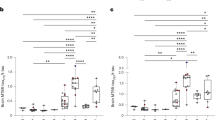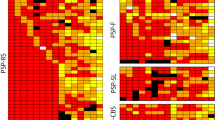Abstract
Clinical and pathological evidence supports the notion that corticobasal degeneration (CBD) and progressive supranuclear palsy (PSP) are distinct, but overlapping neurodegenerative tauopathies. Although both disorders are characterized by abnormal accumulation of 4-repeat tau, they display distinct proteolytic profiles of tau species and they have distinct astrocytic lesions, astrocytic plaques in CBD and tufted astrocytes in PSP. To investigate other differences between these two disorders at the molecular level, we compared the profiles of proteins from caudate nucleus of CBD and PSP by quantitative two-dimensional difference gel electrophoresis. Twenty-one protein spots differentially expressed in CBD and PSP were dissected for mass spectrometry (MS). One of the spots was identified by MS to contain light chain (LC) ferritin. Western blot analysis verified the presence of LC ferritin in this spot and showed that this protein was two-fold higher in caudate of CBD than that of PSP samples. These results were confirmed by LC ferritin immunohistochemistry. Co-labeling of caudate nucleus with tau and LC ferritin antibodies showed the presence of LC ferritin immunoreactivity in astrocytic plaques of CBD, but minimal labeling of tufted astrocytes in PSP. This difference did not reflect the extent of gliosis. Analysis of other brain regions in CBD and PSP showed no difference in LC ferritin levels. Together the data suggest that LC ferritin is a unique marker of astrocytic lesions in CBD, adding further support to the notion that CBD and PSP are distinct clinicopathologic entities.




Similar content being viewed by others
References
Arai T, Ikeda K, Akiyama H et al (2004) Identification of amino-terminally cleaved tau fragments that distinguish progressive supranuclear palsy from corticobasal degeneration. Ann Neurol 55:72–79
Baldi A, Lombardi D, Russo P et al (2005) Ferritin contributes to melanoma progression by modulating cell growth and sensitivity to oxidative stress. Clin Cancer Res 11:3175–3183
Cheepsunthorn P, Palmer C, Connor JR (1998) Cellular distribution of ferritin subunits in postnatal rat brain. J Comp Neurol 400:73–86
Dexter DT, Jenner P, Schapira AHV, Marsden CD (1992) Alterations in levels of iron, ferritin, and other trace metals in neurodegenerative diseases affecting the basal ganglia. Annal Neurol 32:S94–S100
Di Maria E, Tabaton M, Vigo T et al (2000) Corticobasal degeneration shares a common genetic background with progressive supranuclear palsy. Ann Neurol 47:374–377
Dickson DW (1999) Neuropathologic differentiation of progressive supranuclear palsy and corticobasal degeneration. J Neurol 246(Suppl 2):II6–II15
Dickson DW, Crystal HA, Mattiace LA et al (1992) Identification of normal and pathological aging in prospectively studied nondemented elderly humans. Neurobiol Aging 13:179–189
Feany MB, Dickson DW (1995) Widespread cytoskeletal pathology characterizes corticobasal degeneration. Am J Pathol 146:1388–1396
Feany MB, Ksiezak-Reding H, Liu WK et al (1995) Epitope expression and hyperphosphorylation of tau protein in corticobasal degeneration: differentiation from progressive supranuclear palsy. Acta Neuropathol 90:37–43
Fujioka S, Murray ME, Foroutan P et al (2011) Magnetic resonance imaging with 21.1 T and pathological correlations–diffuse Lewy body disease. Rinsho Shinkeigaku 51:603–607
Houlden H, Baker M, Morris HR et al (2001) Corticobasal degeneration and progressive supranuclear palsy share a common tau haplotype. Neurology 56:1702–1706
Kakhlon O, Gruenbaum Y, Cabantchik ZI (2002) Ferritin expression modulates cell cycle dynamics and cell responsiveness to H-ras-induced growth via expansion of the labile iron pool. Biochem J 363:431–436
Kaneko Y, Kitamoto T, Tateishi J, Yamaguchi K (1989) Ferritin immunohistochemistry as a marker for microglia. Acta Neuropathol 79:129–136
Komori T, Arai N, Oda M et al (1998) Astrocytic plaques and tufts of abnormal fibers do not coexist in corticobasal degeneration and progressive supranuclear palsy. Acta Neuropathol 96:401–408
Kulathingal J, Ko LW, Cusack B, Yen SH (2009) Proteomic profiling of phosphoproteins and glycoproteins responsive to wild-type alpha-synuclein accumulation and aggregation. Biochim Biophys Acta 1794:211–224
Quintana C, Bellefqih S, Laval JY et al (2006) Study of the localization of iron, ferritin, and hemosiderin in Alzheimer’s disease hippocampus by analytical microscopy at the subcellular level. J Struct Biol 153:42–54
Sergeant N, Wattez A, Delacourte A (1999) Neurofibrillary degeneration in progressive supranuclear palsy and corticobasal degeneration: tau pathologies with exclusively “exon 10” isoforms. J Neurochem 72:1243–1249
Sha S, Hou C, Viskontas IV, Miller BL (2006) Are frontotemporal lobar degeneration, progressive supranuclear palsy and corticobasal degeneration distinct diseases? Nat Clin Pract Neurol 2:658–665
Surguladze N, Thompson KM, Beard JL, Connor JR, Fried MG (2004) Interactions and reactions of ferritin with DNA. J Biol Chem 279:14694–14702
Wray S, Saxton M, Anderton BH, Hanger DP (2008) Direct analysis of tau from PSP brain identifies new phosphorylation sites and a major fragment of N-terminally cleaved tau containing four microtubule-binding repeats. J Neurochem 105:2343–2352
Yamada T, McGeer PL, McGeer EG (1992) Appearance of paired nucleated, Tau-positive glia in patients with progressive supranuclear palsy brain tissue. Neurosci Lett 135:99–102
Acknowledgments
We thank Mr. Benjamin Madden at Mayo Proteomic Research Center for assistance with mass spectrometric analyses. We also thank Linda Rousseau and Virginia Phillips for tissue processing. This study was supported by CurePSP/The Society for Progressive Supranuclear Palsy and by the Mayo Foundation for Education and Research.
Author information
Authors and Affiliations
Corresponding author
Rights and permissions
About this article
Cite this article
Ebrahim, A.S., Kulathingal, J., Murray, M.E. et al. A proteomic study identifies different levels of light chain ferritin in corticobasal degeneration and progressive supranuclear palsy. Acta Neuropathol 122, 727–736 (2011). https://doi.org/10.1007/s00401-011-0888-x
Received:
Revised:
Accepted:
Published:
Issue Date:
DOI: https://doi.org/10.1007/s00401-011-0888-x




